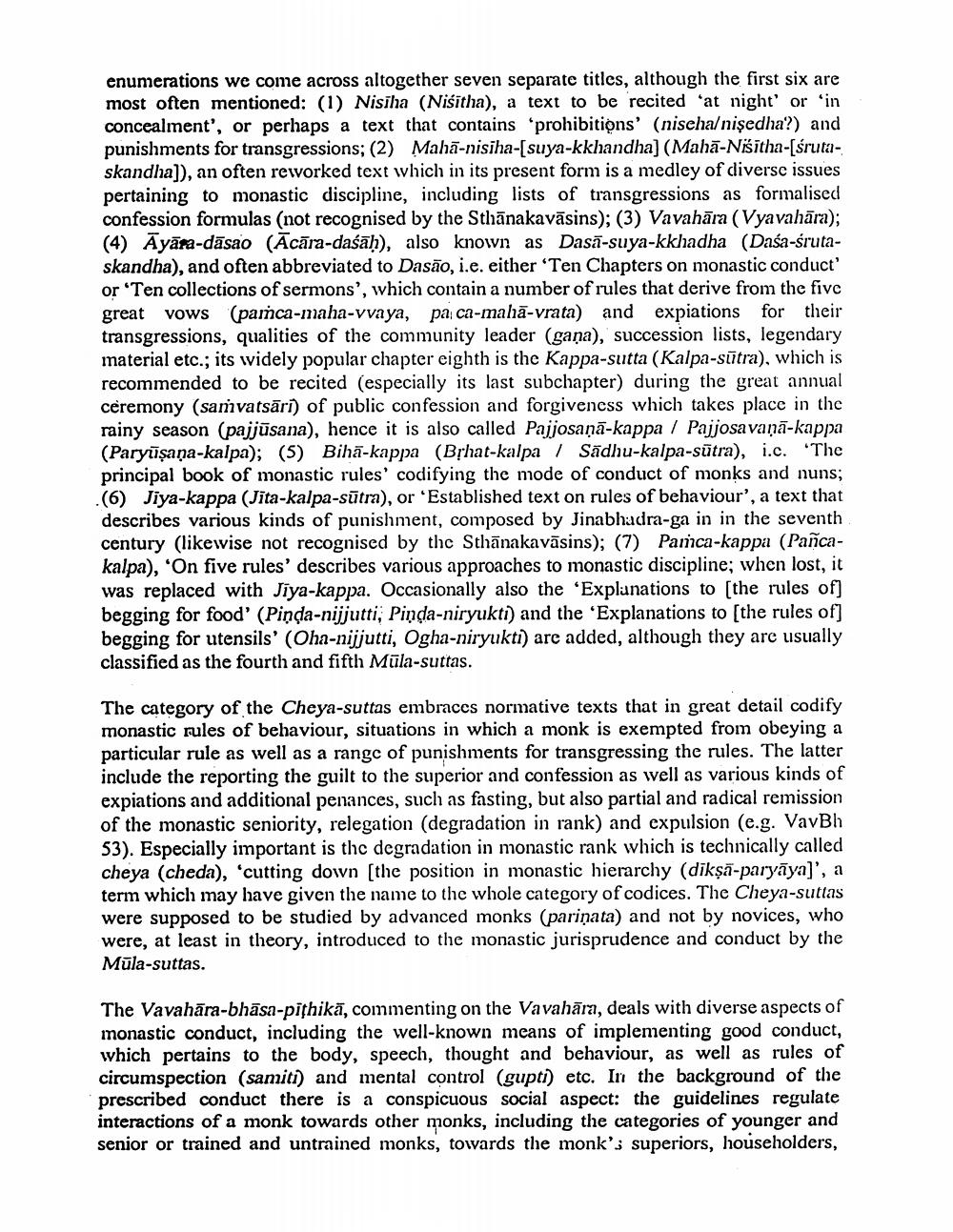________________
enumerations we come across altogether seven separate titles, although the first six are most often mentioned: (1) Nisiha (Niśitha), a text to be recited ‘at night' or 'in concealment', or perhaps a text that contains 'prohibitions' (niseha/nişedha?) and punishments for transgressions; (2) Mahā-nisiha-[suya-kkhandha) (Mahā-Nišitha-[śrutaskandha]), an often reworked text which in its present form is a medley of diverse issues pertaining to monastic discipline, including lists of transgressions as formalised confession formulas (not recognised by the Sthānakavāsins); (3) Vavahāra (Vyavahāra); (4) Ayāra-dāsao (Acāra-daśā), also known as Dasā-suya-kkhadha (Dasa-śrutaskandha), and often abbreviated to Dasão, i.e. either 'Ten Chapters on monastic conduct' or 'Ten collections of sermons', which contain a number of rules that derive from the five great vows (parca-maha-vvaya, pa ca-malā-vrata) and expiations for their transgressions, qualities of the community leader (gana), succession lists, legendary material etc.; its widely popular chapter eighth is the Kappa-sutta (Kalpa-sūtra), which is recommended to be recited (especially its last subchapter) during the great annual ceremony (samvatsāri) of public confession and forgiveness which takes place in the rainy season (pajjūsana), hence it is also called Pajjosaņā-kappa / Pajjosavaņā-kappa (Paryūṣaṇa-kalpa); (5) Bihā-kappa (Bịhat-kalpa | Sādhu-kalpa-sūtra), i.c. 'The principal book of monastic rules' codifying the mode of conduct of monks and nuns; (6) Jiya-kappa (Jita-kalpa-sūtra), or 'Established text on rules of behaviour', a text that describes various kinds of punishment, composed by Jinabhadra-ga in in the seventh century (likewise not recognised by the Sthānakavāsins); (7) Pamca-kappa (Pascakalpa), 'On five rules' describes various approaches to monastic discipline; when lost, it was replaced with Jiya-kappa. Occasionally also the 'Explanations to the rules of] begging for food' (Pinda-nijjutti, Pinda-niryukti) and the 'Explanations to the rules of] begging for utensils' (Oha-nijjutti, Ogha-niryukti) are added, although they are usually classified as the fourth and fifth Mūla-suttas.
The category of the Cheya-suttas embraces normative texts that in great detail codify monastic rules of behaviour, situations in which a monk is exempted from obeying a particular rule as well as a range of punishments for transgressing the rules. The latter include the reporting the guilt to the superior and confession as well as various kinds of expiations and additional penances, such as fasting, but also partial and radical remission of the monastic seniority, relegation (degradation in rank) and expulsion (e.g. VavBh 53). Especially important is thc degradation in monastic rank which is technically called cheya (cheda), 'cutting down the position in monastic hierarchy (dikṣā-paryāya]', a term which may have given the name to the whole category of codices. The Cheya-suttas were supposed to be studied by advanced monks (pariņata) and not by novices, who were, at least in theory, introduced to the monastic jurisprudence and conduct by the Mūla-suttas.
The Vavahāra-bhāsa-pithikā, commenting on the Vavahāra, deals with diverse aspects of monastic conduct, including the well-known means of implementing good conduct, which pertains to the body, speech, thought and behaviour, as well as rules of circumspection (saniti) and mental control (gupti) etc. In the background of the prescribed conduct there is a conspicuous social aspect: the guidelines regulate interactions of a monk towards other monks, including the categories of younger and senior or trained and untrained monks, towards the monk'; superiors, householders,




